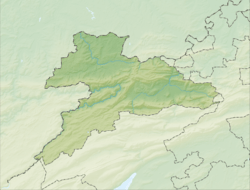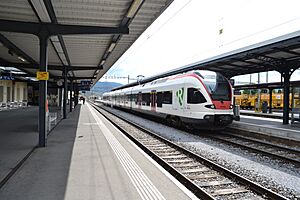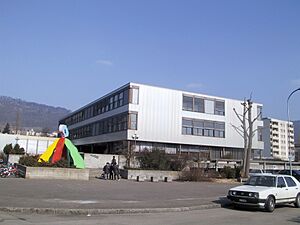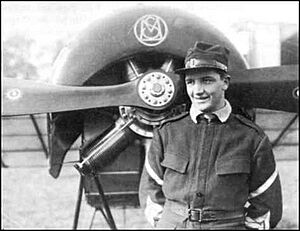Delémont facts for kids
Quick facts for kids
Delémont
|
||
|---|---|---|

Delémont Castle (left) and Saint-Marcel Church
|
||
|
||
| Country | Switzerland | |
| Canton | Jura | |
| District | Delémont | |
| Area | ||
| • Total | 21.97 km2 (8.48 sq mi) | |
| Elevation | 435 m (1,427 ft) | |
| Population
(Dec 2020 )
|
||
| • Total | 12,618 | |
| • Density | 574.33/km2 (1,487.5/sq mi) | |
| Postal code |
2800
|
|
| Surrounded by | Develier, Courtételle, Rossemaison, Courrendlin, Courroux, Soyhières, Mettembert, Bourrignon | |
| Twin towns | Belfort (France) | |
Delémont is the capital city of the Swiss canton of Jura. It's also known as Delsberg in German. About 12,000 people live here.
Contents
- History of Delémont
- Geography of Delémont
- Climate in Delémont
- Delémont's Coat of Arms
- People of Delémont (Demographics)
- Economy of Delémont
- Religion in Delémont
- Transportation in Delémont
- Important Heritage Sites
- Things to See (Tourism)
- International Connections
- Culture
- Education in Delémont
- Sports
- Notable People from Delémont
- See also
History of Delémont
The area around Delémont has been settled for a very long time. People lived here as far back as the middle Bronze Age. Scientists have found old burial sites and settlements from that time.
There's also proof of a Roman settlement. They found Roman buildings and even some old coins.
The city's name, Delemonte, was first written down around 736 AD. Later, in 1131, the German name Telsperg appeared. The name likely combines a Germanic name with the Latin word for "mountain."
Becoming a City
For a long time, the region belonged to the counts of Alsace. In 1271, it was sold to the Bishop of Basel. At that time, Delémont was a small, fortified village with two castles.
On January 6, 1289, Bishop Peter Reich von Reichenstein gave Delémont special city rights. This meant the city could govern itself more and grow. They could collect taxes on things like wine and food. This money helped the city pay for its needs.
From 1289 to 1793, Delémont was the capital of its own area, called the estate of Delémont.
Old Town and Buildings
The old part of Delémont was built in a nearly square shape. It had two main long streets crossed by three smaller ones. City walls surrounded the town, and these walls were made stronger in the 14th century.
There were four gates to enter the city. One of them, the Porte des Près, was closed up in 1487 after a big fire. You can still see beautiful fountains in the old town, built in the Renaissance style.
Many important public buildings were rebuilt in the 18th century. The Bishop's Castle, which was a summer home, was rebuilt from 1716 to 1721. The town hall was built between 1742 and 1745. The Saint-Marcel Church was built from 1762 to 1767, replacing an older Gothic church.
Religious Life
The town's church was first mentioned in 1255. During the Protestant Reformation, a group of religious leaders from Moutier-Grandval moved to Delémont.
Later, during the Counter-Reformation, a monastery and a convent were built. The Ursuline convent, started in 1698, provided education for young girls for almost a century.
The chapel of Saint-Imier became a very popular place for pilgrimages in the 17th century. People would visit it to honor Mary.
French Rule and Swiss Canton
In 1793, French Revolutionary soldiers took over Delémont. The city became part of a French department. After Napoleon's defeat, the region became part of the Canton of Bern in 1815.
Under French rule, the old way of governing the city changed. But when it became part of Bern, the old leaders quickly regained power. This changed again in 1831, when a new movement gave all residents full citizenship rights.
During the 19th century, more German-speaking people moved to Delémont because of new factories. For a while, the city was bilingual. However, since 1920, fewer people speak German.
Since 1947, Delémont has been a key place for people who wanted the Jura region to become its own canton, separate from Bern. In 1979, the new Canton of Jura was created, and Delémont became its capital.
Geography of Delémont
Delémont is located about 30 kilometers (19 miles) southwest of Basel. It sits in a wide valley in the Jura Mountains. The Sorne river flows through the city and then joins the Birs river.
A large part of the municipality's land is used for farming. There are also many forests. The highest point in the municipality is la Chaive, which is 930 meters (3,050 feet) high.
The towns of Les Rondez and Les Vorbourgs are also part of the Delémont municipality.
Climate in Delémont
Delémont has a climate that is a mix of oceanic and humid continental. This means it has moderate temperatures and rainfall throughout the year.
Between 1981 and 2001, Delémont had about 134 days of rain or snow each year. The wettest month is usually May, and the driest is February.
| Climate data for Delémont (1991–2020) | |||||||||||||
|---|---|---|---|---|---|---|---|---|---|---|---|---|---|
| Month | Jan | Feb | Mar | Apr | May | Jun | Jul | Aug | Sep | Oct | Nov | Dec | Year |
| Mean daily maximum °C (°F) | 4.5 (40.1) |
6.7 (44.1) |
11.2 (52.2) |
15.1 (59.2) |
19.0 (66.2) |
22.8 (73.0) |
24.9 (76.8) |
24.6 (76.3) |
20.0 (68.0) |
15.2 (59.4) |
8.8 (47.8) |
5.1 (41.2) |
14.8 (58.6) |
| Daily mean °C (°F) | 0.9 (33.6) |
1.9 (35.4) |
5.4 (41.7) |
9.1 (48.4) |
13.2 (55.8) |
16.9 (62.4) |
18.7 (65.7) |
18.2 (64.8) |
14.1 (57.4) |
10.0 (50.0) |
4.8 (40.6) |
1.7 (35.1) |
9.6 (49.3) |
| Mean daily minimum °C (°F) | −2.4 (27.7) |
−2.1 (28.2) |
0.4 (32.7) |
3.2 (37.8) |
7.5 (45.5) |
11.1 (52.0) |
12.6 (54.7) |
12.5 (54.5) |
9.2 (48.6) |
6.0 (42.8) |
1.6 (34.9) |
−1.5 (29.3) |
4.8 (40.6) |
| Average precipitation mm (inches) | 52 (2.0) |
50 (2.0) |
52 (2.0) |
65 (2.6) |
93 (3.7) |
91 (3.6) |
94 (3.7) |
96 (3.8) |
72 (2.8) |
73 (2.9) |
69 (2.7) |
68 (2.7) |
876 (34.5) |
| Average snowfall cm (inches) | 8 (3.1) |
9 (3.5) |
5 (2.0) |
1 (0.4) |
0 (0) |
0 (0) |
0 (0) |
0 (0) |
0 (0) |
0 (0) |
2 (0.8) |
8 (3.1) |
33 (13) |
| Average precipitation days (≥ 1.0 mm) | 10.0 | 9.3 | 9.1 | 9.4 | 12.4 | 11.1 | 10.7 | 10.4 | 8.8 | 10.7 | 10.4 | 11.1 | 123.4 |
| Average snowy days (≥ 1.0 cm) | 2.8 | 2.8 | 1.3 | 0.4 | 0.0 | 0.0 | 0.0 | 0.0 | 0.0 | 0.1 | 0.8 | 2.5 | 10.7 |
| Average relative humidity (%) | 86 | 81 | 75 | 72 | 75 | 74 | 72 | 74 | 79 | 84 | 87 | 87 | 79 |
| Source: MeteoSwiss | |||||||||||||
Delémont's Coat of Arms
The city's coat of arms shows a silver bishop's staff (called a crosier) over six silver hills on a red background.
People of Delémont (Demographics)
As of 2008, about 23.9% of the people living in Delémont were foreign nationals. Most people in Delémont speak French as their main language. Italian and German are also spoken by smaller groups.
In 2008, the population was almost half male (48.6%) and half female (51.4%). About 32.4% of the people living in Delémont in 2000 were born there.
Economy of Delémont
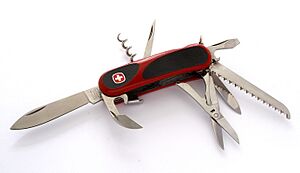
By 1770, Delémont was already a busy center for trade and making things. Only about a quarter of the people still worked in farming. In the 19th century, factories grew, making steel, watches, machines, cigars, and cement.
One very famous company from Delémont is Wenger, known for its Swiss Army knives. These knives are now part of Victorinox.
Today, Delémont is the main place for business and government in the Jura canton. Besides its traditional factories, many people now work in service jobs. However, some people still need to find jobs in bigger cities like Basel or Biel.
In 2010, the unemployment rate in Delémont was 7.4%. Many people work in manufacturing, like making things in factories. A lot of jobs are also in the service sector, such as sales, transportation, hotels, and healthcare.
Many people travel into Delémont for work each day. About 13.7% of workers use public transportation, and 55.3% use a private car.
Religion in Delémont
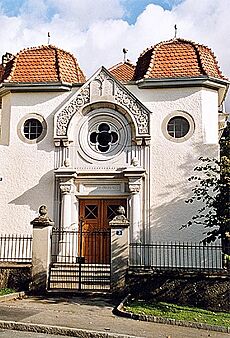
According to the 2000 census, most people in Delémont are Roman Catholic (68.9%). A smaller group (11.2%) belongs to the Swiss Reformed Church. There are also people who follow other Christian faiths, Islam, and Judaism. Some people do not belong to any church.
Transportation in Delémont
Delémont is an important transport hub. The Delémont railway station connects train lines from Paris, Basel, and Bienne.
The city also has good road connections. It's on the main road between Basel and Bienne. In 1998, the first part of the A16 motorway in the Jura canton opened, connecting Delémont to Porrentruy.
Trains first arrived in Delémont from Basel in 1875. During World War II, the railway station was accidentally bombed on September 8, 1944, by the Allies, injuring some railway workers.
A good bus system helps people travel around the countryside near Delémont.
Important Heritage Sites
Several places in Delémont are listed as important Swiss heritage sites:
- The Vorbourg Chapel
- The Prince-Bishops' Castle
- St-Marcel's Church
- The Museum jurassien d’art et d’histoire and the Tour Rouge
- The historic turntable for locomotives and the railway roundhouse
The entire old town of Delémont is also part of the Inventory of Swiss Heritage Sites.
Things to See (Tourism)
The old city center of Delémont still looks much like it did in medieval times. You can see two old city gates from the 18th century: the Porte au Loup and the Porte de Porrentruy. Parts of the old city wall, including the Tour des Archives from the 13th century, are also still standing.
The city squares feature beautiful fountains from the 16th century, built in the Renaissance style.
The Catholic church of Saint-Marcel was built between 1762 and 1767. It combines baroque and classical styles. Other important buildings from the time of the Bishops of Basel include the Hôtel de Ville (Town Hall) and the Episcopal Palace.
The synagogue of Delémont is in the western part of the city. You can also find the Castle of Domont, built in 1560, which is now a restaurant. There are also ruins of an old castle called the Vorbourg, with a chapel next to it.
International Connections
Delémont has "twin town" relationships with other cities around the world. This means they share cultural and educational ties.
Twin towns – sister cities
Delémont is twinned with:
 Belfort, France
Belfort, France La Trinidad, Nicaragua
La Trinidad, Nicaragua
Culture
In 2006, Delémont received the Wakker Prize. This award is given to places in Switzerland that do a great job of preserving their historical buildings and architecture.
Education in Delémont
In Delémont, many people have completed higher education. About 32.6% have finished non-mandatory upper secondary education, and 11.5% have gone on to university or a specialized college.
The Canton of Jura's school system starts with two years of optional Kindergarten. Then, students attend six years of Primary school. After that, there are three years of mandatory lower Secondary school. Students can then choose to go to an upper Secondary school or start an apprenticeship.
During the 2009–10 school year, Delémont had 1,471 students in 78 classes. This included kindergarten, primary, and lower secondary schools.
Delémont is also home to the Bibliothèque municipale de Delémont, which is the city's public library. In 2008, the library had over 32,000 books and other media.
Sports
The local football (soccer) club, SR Delémont, plays in the Swiss Challenge League.
Notable People from Delémont
- Eugène Daumas (1803–1871), a French general and writer.
- Alfred Comte (1895–1965), a Swiss aviation pioneer.
- Job (born 1927), also known as André Jobin, a Swiss comics creator.
- Heidi Baader-Nobs (born 1940), a Swiss composer.
- Gérard Daucourt (born 1941), a Catholic Bishop.
- Pierre Margot (born 1950), a Swiss forensic scientist who invented a special light source for investigations.
- Dominique Baettig (born 1953), a psychiatrist and politician.
- Maurice Kottelat (born 1957), a Swiss scientist who studies freshwater fish.
- Sport
- Julien Vauclair (born 1979), a Swiss former professional ice hockey player.
See also
 In Spanish: Delémont para niños
In Spanish: Delémont para niños




